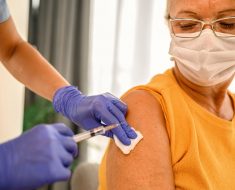Higher step counts and cardiorespiratory fitness in adolescents were associated with a lower heart rate at rest ― confirming an association long identified in adults, according to a study presented at the Pediatric Academic Societies (PAS) 2023 Meeting.
The new findings provide a new means for pediatricians to measure physical fitness, the researchers said.
“It really changes the way we evaluate kids’ fitness and gives us a new method of judging physical fitness other than body mass index,” said Susan Gasparino, MD, an instructor in pediatrics at the University of Rochester Medical Center, in New York, who led the study.
Using data from the 2005 to 2006 National Health and Nutrition Examination Survey, Gasparino and her colleagues examined the association between resting heart rate (RHR) and step count among 899 children and 1640 adolescents aged 6 to 19 years.
In the adolescent group, the mean RHR was 74.9 among those who walked more than 10,000 steps per day (n = 414) and 79.3 for those whose step counts fell below that cutoff (n = 1226) (P < .001). For each additional 1000 steps per day, RHR decreased by an average of 0.7 beats per minute (bpm) in this group (P < .001).
In the younger age group, mean RHR was 85.3 among children who took more than 10,000 steps per day (n = 447) and 86.3 among those who did not reach that threshold (n = 452) (P = .29). For each additional 1000 steps per day, RHR decreased by an average of 0.3 bpm in this group (P = .02)
Gasparino said next steps in research could include controlling for confounders, such as baseline anxiety and medications that could blunt the heart rate.
If similar results bear out in future studies, monitoring RHR could be incorporated into fitness programs for children and adolescents. Doing so could obviate “the need for intensive treadmill assessments using VO2max, time-consuming and emotionally fraught school-based physical fitness tests, and the fear and potential shame of the scale,” the researchers said.
Gasparino said measuring RHR during a 3-minute step test could help organizations and governments determine whether fitness programs are improving cardiovascular and overall health and could help them direct “funding and resources to the programs that are effective.” Such a test could also be incorporated into pediatrician wellness checks, she noted.
“It’s an exciting development, and [RHR measurement] holds a lot of promise as a clinical tool that can be applicable in a lot of settings,” said Nicholas M. Edwards, MD, MPH, a sports medicine pediatrician and an associate professor of orthopedics at the University of Minnesota, in Minneapolis.
Edwards told Medscape Medical News that because measurement of fitness in clinical settings is difficult, finding ways to “assess fitness in the office with the equipment already at hand would be a superb development.”
If use of RHR to measure fitness “is validated in a clinical setting,” Edwards said, “I think adoption would be a natural next step.”
Edwards has disclosed no relevant financial relationships.
Pediatric Academic Societies (PAS) 2023 Meeting: Abstract 115. Presented Friday, April 28, 2023.
Sarah Tilyou is a medical journalist in New York.
For more news, follow Medscape on Facebook, Twitter, Instagram, and YouTube.
Source: Read Full Article





